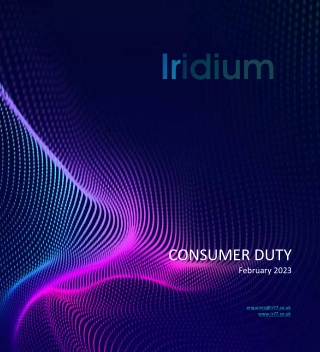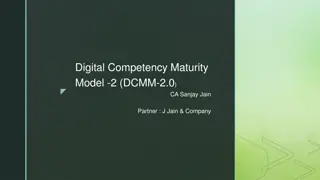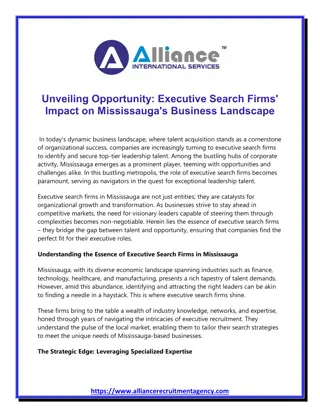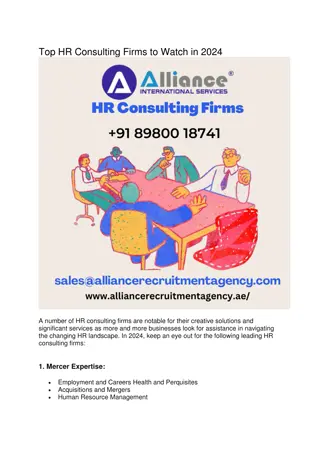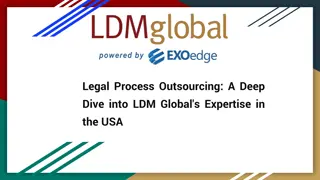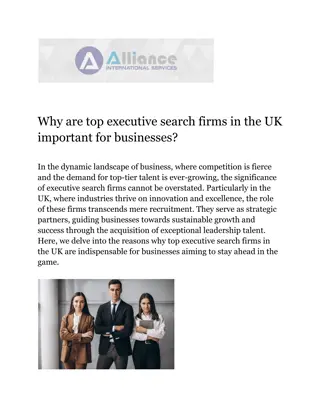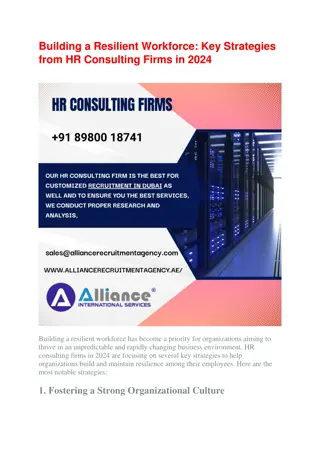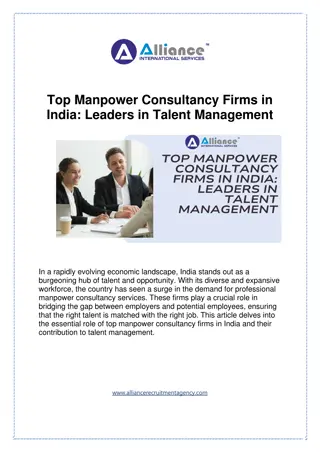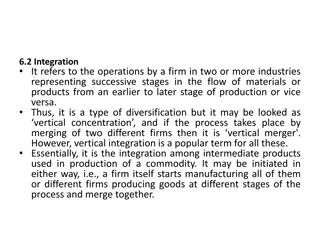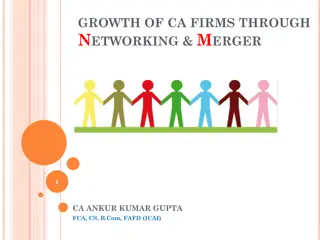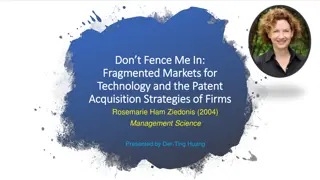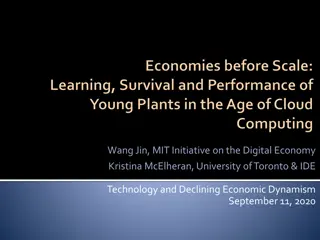Family Firms Growth Strategies and Practices
This content discusses the strengths, weaknesses, and practices of family firms, emphasizing the importance of balancing family dynamics with business operations for sustainable growth. It explores the influence of familiness on continuous strategic renewal and the significant role of networking in the growth processes of family businesses.
Download Presentation

Please find below an Image/Link to download the presentation.
The content on the website is provided AS IS for your information and personal use only. It may not be sold, licensed, or shared on other websites without obtaining consent from the author.If you encounter any issues during the download, it is possible that the publisher has removed the file from their server.
You are allowed to download the files provided on this website for personal or commercial use, subject to the condition that they are used lawfully. All files are the property of their respective owners.
The content on the website is provided AS IS for your information and personal use only. It may not be sold, licensed, or shared on other websites without obtaining consent from the author.
E N D
Presentation Transcript
#3: . Family Firms Growth Strategies and Practices. : : Sarah Drakopoulou Dodd :
Family Firms: Growth Strategies and Practices. Strengths and Weaknesses of the Family Firm. Mapping the Stakeholders in Family Firms. Balancing Family & Firm: Systems & Subsystems. Familiness and continuous strategic renewal in the family firms. The Role of Networking in the Growth Processes of Family Firms: An International Study. 4
Good news about family enterprises. Bad news about family enterprises. Family and Firm: Systems, Subsystems and Overlaps. Which aspects of familiness influence continuous strategic renewal in family firms? 5
Good news about family enterprises : , #3: . Family Firms Growth Strategies and Practices. : , : Sarah Drakopoulou Dodd, :
What is a Family Business? A family business is a synthesis of: Ownership control (15%+) by two or more members of a family or a partnership of families. Strategic influence by family members on the management of the firm. Concern for family relationships. The dream (possibility) of continuity across generations. 7
Lets start with the good news about family enterprises (1 of 2) Family firms make a vital contribution to the world economy. Growing Contribution to GNP of Family Firms. Family firms are among the world s largest. The world s oldest businesses are family firms. Many of the world s best known brands are family firms. 8
Lets start with the good news about family enterprises (2 of 2) Family firms perform better than non-family firms. Family firms have lots of strategic advantages. And family firms have a special place in Greece. 9
Family Businesses Constitute 80 98% of businesses in U.S. and other market economies. Generate 49% of GDP in U.S. and more than 75% in most other countries. Employ 59% of private sector U.S. workforce and more than 85% of working population overseas. Created about 80% of all new jobs in the 1980 s and 1990 s 10
Family firms are among the worlds largest 25% of top 500 US companies are family controlled. 1/3rdof Standard & Poor s top 500. Half of Top French and German public companies are still family owned. 11
Examples of Family Businesses No 1: Wal-Mart Stores, USA. Founded: 1962. Revenues: (in $ million) 469,000. No 10: Samsung, Korea. Founded: 1938. Revenues: (in $ million) 268,000. 12
The Worlds Biggest Family Firms Wal-mart, USA. Turnover (in $ million) 469,000. Samsung, Korea. Turnover (in $ million) 268,000. Toyota, Japan. Turnover (in $ million) 222,000. Cargill, USA. Turnover (in $ million) 136,000. 13
The worlds oldest businesses are family firms (1 of 4) The world s oldest family business: Houshi inn and spa is a Japanese traditional inn in Komatsu, Japan. Founded in 718. 46th generation. Loved and enriched by all who have visited her, at 1,300 years of age, Houshi is the oldest inn in the world . 14
The worlds oldest businesses are family firms (2 of 4) The world s longest-lived family business: Kongo Gumi is a construction firm in Osaka, Japan. Founded in 578 and sold in 2007. 40th generation. Prince Shotoku brought Kongo family members to Japan from Korea. More than 1,400 years ago to build the Buddhist Shitennoji Temple, which still stands. 15
The worlds oldest businesses are family firms (3 of 4) Islay s Ice Cream from a dairy founded in 1598. It is based where the family has lived for more than 900 years! 16
The worlds oldest businesses are family firms (3 of 3) Ch teau de Goulaine, Vineyard, museum, butterfly collection in Haute Goulaine, France. Founded in 1000. It is Europe s oldest business - more than 1000 years old. Fonderia Pontificia Marinelli, Bell foundry in Agnone, Italy. Founded in 1000. Barone Ricasoli, Wine and olive oil in Siena, Italy. Founded in 1141. Barovier & Toso , Glass making in Murano Venezia, Italy. Founded in 1295 20th generation. 17
The worlds oldest businesses are family firms (4 of 4) Zildjian is America s oldest company. The company`s cymbals have been made since 1623. An alchemist in Constantinople developed a special melting method for making cymbals. Which is still a closely guarded trade secret today. His family were given the name Zildjian, which means son of the cymbal maker. 18
Many of the worlds best known brands are family firms Heineken, Michelin, Ikea, L'Or al, Est e Lauder, United Colors of Benetton, Marriot. 19
And family firms have a special place in Greece Between 50% and 65% of very large firms are in family control. And fully 100% of middle sized firms. 3E / Frigoglass Titan Alphabank MOH / Bardinoyiannis Group Fourlis Boutaris 20
Family firms have lots of strategic advantages (1 of 2) Heightened commitment, longer term perspectives, patient capital; sustained values and vision; continuity, specialized knowledge; 21
Family firms have lots of strategic advantages (2 of 2) easier organizational renewal, due to lack of external owners or directors; cultural preferences for entrepreneurship and innovation; the personalism and particularism associated with the family firm form enhance rapid and flexible opportunistic investments based on intuitive heuristics (Carney, 2005). 22
Special organizational competencies of the family firm Overlapping responsibilities of owners and managers, along with small company size, enable rapid speed to market. Concentrated ownership structure leads to higher returns on investment. Desire to protect the family name and reputation often translates into high product quality and higher Return On Investment ( ROI ) Patient capital, lower admin costs, skills, knowledge transfer, agility in rapidly changing markets. 23
Bad news about family enterprises : , #3: . Family Firms Growth Strategies and Practices. : , : Sarah Drakopoulou Dodd, :
Weaknesses Surviving Transition Family and Business Boundary Problems Succession Imperatives 25
Surviving Transition In their first 5 years of operation, approximately 85% of entrepreneurial and family-owned companies disappear. Among those that survive, only 30% are successfully transferred to the second generation of the founding-family owners. only 12% survive under current ownership to the third generation. Separating family and business roles can be very tough too. 26
Family and Business Boundary Problems Nepotism, confusion, expectations and exploitations, forming one s own identity, the path of self- validation versus zone of comfort, supervising family members. 27
The Challenge To maximize the good news and minimize the bad news about family enterprises, by working out how to build on their special features. 28
Family and Firm: Systems, Subsystems and Overlaps : , #3: . Family Firms Growth Strategies and Practices. : , : Sarah Drakopoulou Dodd, :
Adding family to the mix (1 of 2) 1. Family CEO owner. 2. Heir who works elsewhere, spouse, minor. 3. Non-family manager, rewarded with stock; business partner of family founder. 4. New generation, without shares. Working spouse. 30
Adding family to the mix (2 of 2) 5. Silent equity partner. 6. All the rest of the family, who don t own the firm, or work in it. 7. Non-family employees and managers. People can make great contributions to the family business from any of these positions. 31
Family Business Overlap Family: Harmony, Unity, Self-esteem. Ownership: Stewardship, Values, Return On Investment ( ROI ). Management: Production, Profit. What happens if one of these domains dominates? 32
Family-First Businesses (1 of 2) If family dominates, we have a family first firm. Employment in the business is a birthright. Members of the same generation are paid equally. Perks that transfer from the business to family members are often extensive. 33
Family-First Businesses (2 of 2) Financial systems may be obtuse by design, and secrecy is often paramount. Commitment to continuity depends on the agendas of individual family members. 34
Ownership-First Businesses If ownership dominates, we have an ownership first firm. Investment time horizons and perceived risk are the most significant issues Have shorter time frames within which financial results are evaluated. 35
Management-First Businesses (1 of 2) If management dominates, we have a management first firm. Employment is on the basis of qualifications family is discouraged from working in the business. 36
Management-First Businesses (2 of 2) Performance of employed family members is reviewed in the same manner as the performance of nonfamily managers. Compensation is based on responsibility and performance. Conversation between family members is usually all business. 37
The key to Optimizing Family Firm Performance Balancing and Separating the Domains is the key to Optimizing Family Firm Performance. Process, Systems, Professionalization. 38
Process, Systems, Professionalization (1 of 3) How can we distance the three domains? Spelling out rules and roles clearly. Communicating them well. Planning professionally: strategic plan succession plan 39
Process, Systems, Professionalization (2 of 3) Preparing and using (for family and non-family staff): clear job descriptions, HR policy and procedures, career development guidelines, organizational chart, code of conduct, performance evaluation measures. 40
Process, Systems, Professionalization (3 of 3) Respect the need for privacy. Family members encouraged to work outside business to get experience, and some space. Developing formal governance systems for family and business. Writing a family business protocol. 41
Lets look at some of our studies in Greece Family Firms: Growth Strategies and Practices. Strengths and Weaknesses of the Family Firm. Mapping the Stakeholders in Family Firms. Balancing Family & Firm: Systems & Subsystems. Familiness and continuous strategic renewal in the family firms. The Role of Networking in the Growth Processes of Family Firms: An International Study. 42
Which aspects of familiness influence continuous strategic renewal in family firms? : , #3: . Family Firms Growth Strategies and Practices. : , : Sarah Drakopoulou Dodd, :
Overview (1 of 2) Does strategic renewal impact upon the performance of family firms? Which aspects of familiness act as facilitators or inhibitors of strategic renewal. 44
Overview (2 of 2) A survey instrument captured data on relevant family-related characteristics, organizational renewal, and firm performance. Usable responses were collected from CEOs of 140 family firms in Greece. Regression analysis was used to test hypotheses. 45
What moves a business from now into the future? (1 of 3) Corporate Entrepreneurship shows us that entrepreneurial firms are risk-taking, innovative and proactive (Barringer and Bluedorn,1999, Dess and Lumpkin, 2005.) Dynamic Capabilities scholars argue for constant renewal of the resource base. (Bowman and Ambrosini, 2003, Eisenhardt and Martin, 2000; Teece, Pisano and Shuen, 1997.) 46
What moves a business from now into the future? (2 of 3) Strategic marketers stress a firm s capacity to adjust to change and/or exploit opportunities resulting from environmental changes. (Dreyer and Gronhaug, 2000.) Flexible Strategists emphasize developing enabling strategies for organizing towards Iterative Self-renewal. (Volberda and Lewin ,2003.) 47
What moves a business from now into the future? (3 of 3) Organizational Renewal. Continuous and radical re-creation of organizational structures, processes, and products . Morphing. (Rindova and Kotha 2001.) 48
Organizational Renewal Imperative Does this Organizational Renewal Imperative also apply to family firms, given the benefits of strategic benefits of their stability? 49
Benefits of Family Firms Stability: heightened commitment, longer term perspectives, patient capital, sustained values and vision, continuity, specialized knowledge. 50



